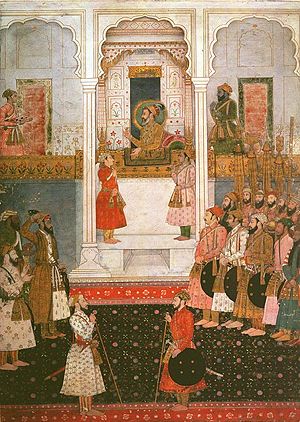Shah Jahan: Difference between revisions
Jump to navigation
Jump to search


imported>Meg Taylor m (spelling: decended -> descended) |
mNo edit summary |
||
| Line 6: | Line 6: | ||
<!--This article uses the Cite.php citation mechanism. If you would like more information on how to add references to this article, please see http://meta.wikimedia.org/wiki/Cite/Cite.php --> | <!--This article uses the Cite.php citation mechanism. If you would like more information on how to add references to this article, please see http://meta.wikimedia.org/wiki/Cite/Cite.php --> | ||
<div class="references-small"><references/> | <div class="references-small"><references/> | ||
</div> | </div>[[Category:Suggestion Bot Tag]] | ||
Latest revision as of 16:00, 17 October 2024

Shah Jahan, holding a durbar in the public audience hall of his palace
Shah Jahan (b.January 5, 1592 – d.January 22, 1666) was the fifth ruler of the Moghul Empire in India from 1628 until 1658. In common with other Moghul rulers his contemporary chroniclers referred to him under a number of different pseudonyms [1] many of which he took to honour his ancestor Tamurlane from whom the Moghuls were descended. In 1616 he was given the title Shah Khurrum Shihab-ud-din Muhammad by his grandfather Akbar. Shah Jahan means Lord of the World and was a title bestowed upon him by his father Jahangir after Jahan's most notable military victories in his father's service in 1617.[2]
Notes
- ↑ Al-Sultan al-'Azam wal Khaqan al-Mukarram, Abu'l-Muzaffar Shihab ud-din Muhammad, Sahib-i-Qiran-i-Sani, Shah Jahan I Padshah Ghazi Zillu'llah
- ↑ http://www.4dw.net/royalark/India4/delhi6.htm